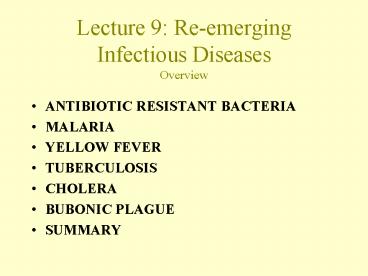Lecture 9: Reemerging Infectious Diseases Overview - PowerPoint PPT Presentation
1 / 9
Title:
Lecture 9: Reemerging Infectious Diseases Overview
Description:
The discovery of penicillin in 1928 and the introduction of other antibiotics ... been moving underground eastwards in infected ground squirrels and prairie dogs. ... – PowerPoint PPT presentation
Number of Views:50
Avg rating:3.0/5.0
Title: Lecture 9: Reemerging Infectious Diseases Overview
1
Lecture 9 Re-emerging Infectious
DiseasesOverview
- ANTIBIOTIC RESISTANT BACTERIA
- MALARIA
- YELLOW FEVER
- TUBERCULOSIS
- CHOLERA
- BUBONIC PLAGUE
- SUMMARY
2
Antibiotic Resistant Bacteria (1)
- The discovery of penicillin in 1928 and the
introduction of other antibiotics such as
streptomycin, chloramphenicol, tetracycline in
the 1940s raised hopes that cures could be found
for all infectious diseases. - Only one family of antibiotics (quinolones) have
been developed since the 1960s. - Strains of Staphylococcus aureus developed
immunity against penicillin in the 1960s.
However, methicillin was still effective. - Methicillin resistant Staphylococcus aureus
(MRSA) were found by the 1980s. Vancomycin was
used as a last resort. - Now vancomycin resistant Staphylococcus aureus
(VRSA) has been observed in hospitals around the
world.
3
Antibiotic Resistant Bacteria (2)
- Streptococcus A which caused scarlet fever more
or less vanished by the 1960s, but it re-emerged
in a much more deadly form in the late 1980s. - Streptoccous pyrogenes (dubbed the flesh eating
bug) causes life threatening necrotizing
fascitis unless stopped by amputation. - Various strains of Pneumonoccus have resistance
to whole classes of antibiotics. - Hospitals are a major breeding ground for
antibiotic resistant bacteria.
4
Malaria
- Resistance to chloroquine was noticed in southern
Asia in the 1950s. By the 1960s some strains of
Plasmodium falciparum had developed resistance to
the 4 main anti-malarial drugs. - A new drug, mefloquine, was adopted in the 1970s,
but resistant strains of falciparum emerged by
the 1980s. - Strains of falciparum in Thailand have evolved an
enzyme which expels all hostile chemicals, making
it resistant to drugs that have not even been
invented.
5
Yellow Fever
- Yellow fever is transmitted by Aedes aegypti (a
mosquito). The reservoir is capuchin and rhesus
monkeys. - Yellow fever was formerly a jungle disease, but
it is now endemic in Latin American cities. - The mosquito is actually more common in North
America, prompting fears that yellow fever could
become endemic there was a sufficient reservoir
of infection.
6
Tuberculosis
- Tuberculosis has been on the increase since the
1980s. It is the main cause of death worldwide. - Many people carry the bacillus but do not develop
symptoms unless their immune system is
compromised. - The resurgence in tuberculosis is associated with
HIV infection. - The problem is compounded by the emergence of
drug resistant strains, partly due to
HIV-infected drug users not completing antibiotic
courses.
7
Cholera
- There were no new pandemics for most of the 20th
century, but the 7th pandemic began in the 1960s
(the El Tor strain). It spread to Latin America
in the 1980s. Developed countries have so far
escaped. - An even more virulent strain (0139) has emerged
in the Sea of Bengal. This may be the beginnings
of 8th pandemic. There is no guarantee that
developed countries will escape.
8
Bubonic Plague
- Bubonic plague was introduced into the Chinese
community in San Francisco at the beginning of
the 20th century. Since then it has been moving
underground eastwards in infected ground
squirrels and prairie dogs. So far few humans
have been infected. - A bubonic plague epidemic in India in 1994
infected 2,500. Fortunately it had low virulence
and was amenable to tetracycline.
9
Conclusion
- The re-emerging old infectious diseases have made
relatively little impact upon the public
imagination in DCs because either they affect
only a small number of people, many of whom are
already sick or poor (e.g. MRSA or TB), or else
they are 'out there' in the Third World where
'life is cheap' and 'these things happen'. - However, given the rapid development of
drug-resistant strains, coupled with rapid air
transportation, it may be only a matter of time
before one of our ghosts from the past come back
to haunt us.































